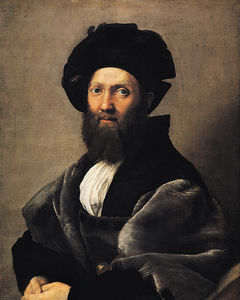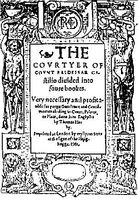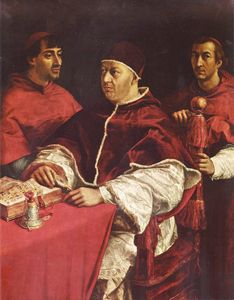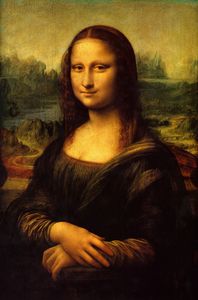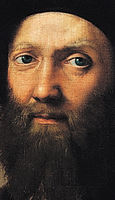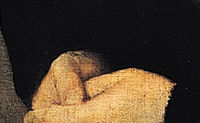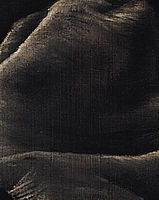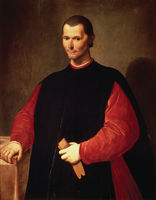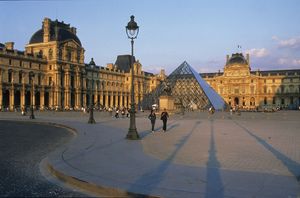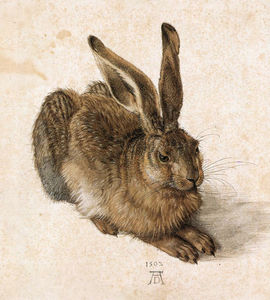Portrait of Baldassare Castiglione
- Date of Creation:
- 1515
- Height (cm):
- 82.00
- Length (cm):
- 67.00
- Medium:
- Oil
- Support:
- Canvas
- Subject:
- Figure
- Framed:
- No
- Art Movement:
- Renaissance
- Created by:
- Current Location:
- Paris, France
- Displayed at:
- Musée du Louvre
- Portrait of Baldassare Castiglione Page's Content
- Story / Theme
- Inspirations for the Work
- Analysis
- Critical Reception
- Locations Through Time - Notable Sales
- Artist
- Art Period
- Bibliography
Portrait of Baldassare Castiglione Story / Theme
-

Book of the Courtier, Old Book Cover
Quick fact:
Rubens admired Raphael's portrait of Castiglione so much that he copied it.
Castiglione's approval:
Referring to this portrait in a Latin elegy dedicated to his wife, Castiglione himself made mention of the uncanny resemblance and the feeling of human presence it emits. Above all, it is the naturalness - the immediacy, freedom of carriage and expressive vivacity - which make this life-like portrait so extraordinarily modern.
-

Raphael's Portrait of Baldassare Castiglione displays the elegance and discretion of dress that characterized a gentleman of the High Renaissance. The intense presence of the model (simple yet refined) makes this image of Castiglione, a good friend of Raphael's and author of The Courtier (published in 1528), the most principal portrait of an accomplished gentleman, exemplifying the perfect courtier described in the book.
Baldassare Castiglione, Count of Novellata, was born in Mantua, Italy on December 2, 1478. He studied the Classics both Mantua and Milan, and practiced the court of Gonzaga. In 1499 Castiglione's father died and he succeeded him in the representative duties as the head of a noble family.
He traveled frequently for Gonzaga, making trips to Milan for the arrival of Louis XII and later to Rome, where he met Guidubaldo da Montefeltro, Duke of Urbino, in 1504. He later passed to that court. It would be court life in Urbino, at the time the most refined and elegant of the Italian courts, that would provide the intellectual atmosphere that would help him frame his ideals outlined in the Courtier. Indeed in 1506, Castiglione wrote and played in Tirsi, a work containing echoes of ancient and contemporary poetry recalling Virgil, Poliziano and Sannazzaro.
When Pope Leo X was elected, Castiglione was sent to Rome as an ambassador of Urbino. It was during this time in Rome that he began to befriend many artists and writers; among these was Raphael, who became a close friend and confidant. It was in part due to this friendship (and a wish to convey it) that Raphael painted the famous Portrait of Baldassare Castiglione.
After the completed portrait, Castiglione returned back to Mantua where he married Ippolita Torelli, a descendant of another noble family. She would die four years later when Castiglione was in Rome acting as ambassador for the Mantuan Dukes. By 1524 Pope Clement VII sent him to Spain as ambassador to the Holy See in Madrid, a position that would eventually see him embroiled in controversy for his role in the Sacco.
The Book of the Courtier was published the year before Castiglione died. It draws upon his time at the court of Urbino and describes the ideal court and courtier - elaborating on some of the philosophical discussions that occurred at Urbino. The book (and Raphael's portrait also) changed the ideal of the gentleman. During the Middle Ages the perfect gentleman was a chivalrous knight, distinguished by his abilities on the battlefield. However, Castiglione's gentleman had to be educated in the Classics, speak several languages, come from noble birth and know how to play several instruments. Thus Castiglione played a large role in defining the Renaissance Man before his death (caused by Black Death) on February 2, 1529.
Portrait of Baldassare Castiglione Inspirations for the Work
Raphael's Portrait of Baldassare Castiglione was no doubt inspired by his close, personal friendship with Castiglione. This holds true whether it was commissioned to celebrate Castiglione's appointment as ambassador or not. The mutual affinity is perfectly expressed in Raphael's astonishingly simple and natural portrait, painted in total accordance with the intentions of its model. Castiglione is depicted in a costume of remarkable elegance and discretion, in line with his concept of the accomplished gentleman.
By including so much of Castiglione's figure in the portrait, Raphael was paying homage to Leonardo, whose Mona Lisa proved a circuit breaker in portraiture. The new format invented by Leonardo had become popular in Italian and Northern European portraiture and was a trend that continued through the 19th and 20th centuries. Part of its effect is to have the subject look larger and grander than in Quattrocento portraits, in keeping with the new dignity and monumentality of the High Renaissance.
The influence of Leonardo da Vinci and its link with Castiglione:
The calm hint of a smile in the Mona Lisa, about which so much has been written, and the composure of her hands were characteristics for a generation whose standards are summed up in the untranslatable word sprezzatura. This term was coined by Baldassare Castiglione in his Book of the Courtier, a guidebook to aristocratic behavior written between 1508 and 1528.
The Mona Lisa's calm assurance and the ease with which she seems to confront the viewer express Castiglione's requirement that one's behavior in public should seem effortless and natural, even in difficult social situations.
Portrait of Baldassare Castiglione Analysis
Composition:
The Portrait of Baldassare Castiglione is yet another example of the perfect balance Raphael achieved during his career in Rome. If Castiglione's Book of the Courtier described the qualities expected of an ideal gentleman in the High Renaissance, Raphael's portrait exemplified them in art.
Castiglione was a friend of Raphael, who represented him with the riposo or inner calm that the author had deemed essential for gentlemen. The picture has been cropped at the bottom, but original copies of the print show it with Castiglione's folded hands in their entirety.
Castiglione's black, white, and gray clothes embody the sobriety and restraint against the flamboyant colors of late Quattrocento style. Raphael created this resonant coloristic effect by placing a monochromatic scheme against the golden gray of the background, which is reflected in warm highlights on the sleeves.
Color palette:
Castiglione's sober doublet is trimmed on the front and upper sleeves in gray squirrel fur laced with black ribbon. Underneath he wears a bloused white shirt. This winter dress (and dark clothes) suggests that the portrait was painted during the winter of 1514-1515 when Castiglione, appointed by the Duke of Urbino to Pope Leo X, was in Rome.
Use of light:
The rather dull harmony of Castiglione's outfit, limited to shades of black, gray and white, is extended in the painting's background of a light and warm gray-beige tone, submersed in diffused light into which his shadow gently fades on the right.
Use of technique:
Raphael's Portrait of Baldassare Castiglione is shown in three-quarter profile from the waist up, seated in an armchair with his hands folded and his gaze fixed on the viewer. This posture, as well as the soft luminescence that envelopes the portrait, are a subtle homage to the Mona Lisa.
Mood, tone and emotion:
The composition is bordered, as in the case of Raphael's other paintings, by a narrow black band, deliberately cutting the image off at the hands and focusing the viewer's attention on the face and the intense gaze.
Portrait of Baldassare Castiglione Critical Reception
Castiglione's ideas were hugely influential for gentlemen of the Renaissance and proved a valuable bulwark against other political theories that were in vogue at this time.
In the early 16th-century while Raphael was creating his masterpieces in the Stanza della Segnatura Italy was being ravaged by war. At the same time Niccolo Machiavelli unveiled his savage perceptions on human nature, The Prince. By contrast, in The Book of the Courtier, Castiglione argues for the civilizing process of human beings. That is, for conversation, dancing and dress sense. Castiglione advises princes that -
"It is a monstrous thing and worthy of blame for men to show themselves valiant and wise in war (which is bad in itself) and in peace and quiet (which are good) to show themselves ignorant".
While Machiavelli was reviled as the devil, The Book of the Courtier was used as a political and social manual throughout Europe. In the centuries that have passed since its creation, Raphael's Portrait of Baldassare Castiglione has become intertwined with the philosophies of Castiglione himself, given the near perfect representation of his values. Its popularity has therefore endured as if in tribute to the idea of the perfect Renaissance gentleman.
Portrait of Baldassare Castiglione Locations Through Time - Notable Sales
Raphael's Portrait of Baldassare Castiglione was a part of King Louis XIV's collection (date of purchase unknown) and has been a treasure of the Louvre's permanent collection, only being moved once in its nearly 500 year history.
It was on display at Atlanta's High Museum of Art as part of its 'Kings as Collectors' series from October 14, 2006 through to January 28, 2007.
Portrait of Baldassare Castiglione Artist
It was said that when Raphael walked out from his house in Rome, dozens of young men would escort him in a pleasant and intellectual company. Whether or not this depiction is accurate, the mere fact it was written can be seen as evidence that Raphael painted as graciously as he lived (or at least seemed to). In him, the harmonious Renaissance ideals of geometry and Classicism produced a prodigy as born out by later works including his Portrait of Baldassare Castiglione. His sense of space, light and subtle order is almost divine.
It is probably these qualities that impressed Baldassare Castiglione, in that he saw his ideals of the perfect gentlemen reflected in Raphael as the perfect artist.
Baldassare Castiglione produced a number of Latin poems, together with an elegy for the death of Raphael entitled De morte Raphaellis.
Portrait of Baldassare Castiglione Art Period
By the time Raphael painted Baldassare Castiglione's portrait both men had already become good friends and distinguished in their respective fields. Indeed, they would have been sufficiently aware of the impact they were having on shaping (in their own ways) what would become known as the Renaissance.
Everything in Raphael's portrait, from the clothing, to the expression, to the pose represents his knowledge of the qualities that made a gentleman in the Italian courts of the Renaissance. The calm, patience and accuracy of the portrait is also significant of what artists of the High Renaissance were trying to achieve.
Portrait of Baldassare Castiglione Bibliography
There are countless books written about Raphael and the High Renaissance. Below is a selection of recommended reading on the artist and his works.
• Brown, Clare & Evans, Mark. Raphael: Cartoons and Tapestries for the Sistine Chapel. V & A Publishing 2010
• Chapman, Hugo, et al. Raphael: From Urbino to Rome. National Gallery Company Ltd, 2008
• De Vecchi, Pier Luigi. Raphael. Abbeville Press Inc. , 2003
• Jones, R. Raphael. Yale University Press, 1987
• Talvacchia, Bette. Raphael. Phaidon Press Ltd, 2007
• Whistler, Catherine. Michelangelo and Raphael Drawings. Ashmolean Museum, 1990

